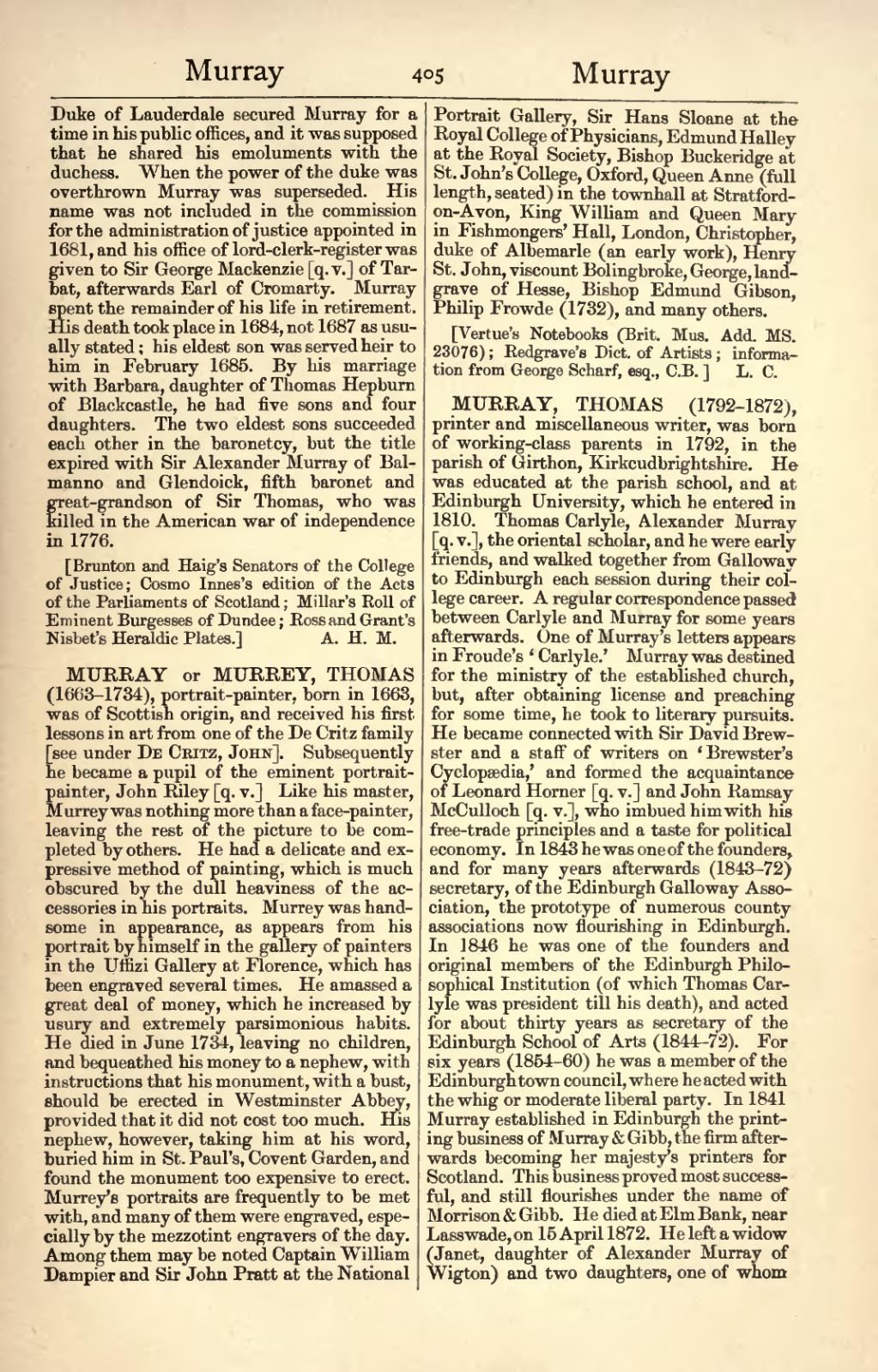Duke of Lauderdale secured Murray for a time in his public offices, and it was supposed that he shared his emoluments with the duchess. When the power of the duke was overthrown Murray was superseded. His name was not included in the commission for the administration of justice appointed in 1681, and his office of lord-clerk-register was given to Sir George Mackenzie [q. v.] of Tarbat, afterwards Earl of Cromarty. Murray spent the remainder of his life in retirement. His death took place in 1684, not 1687 as usually stated ; his eldest son was served heir to him in February 1685. By his marriage with Barbara, daughter of Thomas Hepburn of Blackcastle, he had five sons and four daughters. The two eldest sons succeeded each other in the baronetcy, but the title expired with Sir Alexander Murray of Balmanno and Glendoick, fifth baronet and great-grandson of Sir Thomas, who was killed in the American war of independence in 1776.
[Brunton and Haig's Senators of the College of Justice; Cosmo Innes's edition of the Acts of the Parliaments of Scotland; Millar's Roll of Eminent Burgesses of Dundee; Eoss and Grant's Nisbet's Heraldic Plates.]
MURRAY or MURREY, THOMAS (1663–1734), portrait-painter, born in 1663, was of Scottish origin, and received his first lessons in art from one of the De Critz family [see under De Critz, John]. Subsequently he became a pupil of the eminent portrait-painter, John Riley [q. v.] Like his master, Murrey was nothing more than a face-painter, leaving the rest of the picture to be completed by others. He had a delicate and expressive method of painting, which is much obscured by the dull heaviness of the accessories in his portraits. Murrey was handsome in appearance, as appears from his portrait by himself in the gallery of painters in the Uffizi Gallery at Florence, which has been engraved several times. He amassed a great deal of money, which he increased by usury and extremely parsimonious habits. He died in June 1734, leaving no children, and bequeathed his money to a nephew, with instructions that his monument, with a bust, should be erected in Westminster Abbey, provided that it did not cost too much. His nephew, however, taking him at his word, buried him in St. Paul's, Covent Garden, and found the monument too expensive to erect. Murrey's portraits are frequently to be met with, and many of them were engraved, especially by the mezzotint engravers of the day. Among them may be noted Captain William Dampier and Sir John Pratt at the National Portrait Gallery, Sir Hans Sloane at the Royal College of Physicians, Edmund Halley at the Royal Society, Bishop Buckeridge at St. John's College, Oxford, Queen Anne (full length, seated) in the townhall at Stratford-on-Avon, King William and Queen Mary in Fishmongers' Hall, London, Christopher, duke of Albemarle (an early work), Henry St. John, viscount Bolingbroke, George, landgrave of Hesse, Bishop Edmund Gibson, Philip Frowde (1732), and many others.
[Vertue's Notebooks (Brit. Mus. Add. MS. 23076); Redgrave's Dict. of Artists; information from George Scharf, esq., C.B.]
MURRAY, THOMAS (1792–1872), printer and miscellaneous writer, was born of working-class parents in 1792, in the parish of Girthon, Kirkcudbrightshire. He was educated at the parish school, and at Edinburgh University, which he entered in 1810. Thomas Carlyle, Alexander Murray [q. v.], the oriental scholar, and he were early friends, and walked together from Galloway to Edinburgh each session during their college career. A regular correspondence passed between Carlyle and Murray for some years afterwards. One of Murray's letters appears in Froude's 'Carlyle.' Murray was destined for the ministry of the established church, but, after obtaining license and preaching for some time, he took to literary pursuits. He became connected with Sir David Brewster and a staff of writers on 'Brewster's Cyclopædia,' and formed the acquaintance of Leonard Horner [q. v.] and John Ramsay McCulloch [q. v.], who imbued him with his free-trade principles and a taste for political economy. In 1843 he was one of the founders, and for many years afterwards (1843–72) secretary, of the Edinburgh Galloway Association, the prototype of numerous county associations now flourishing in Edinburgh. In 1846 he was one of the founders and original members of the Edinburgh Philosophical Institution (of which Thomas Carlyle was president till his death), and acted for about thirty years as secretary of the Edinburgh School of Arts (1844–72). For six years (1854–60) he was a member of the Edinburgh town council, where he acted with the whig or moderate liberal party. In 1841 Murray established in Edinburgh the printing business of Murray & Gibb, the firm afterwards becoming her majesty's printers for Scotland. This business proved most successful, and still flourishes under the name of Morrison & Gibb. He died at Elm Bank, near Lasswade, on 15 April 1872. He left a widow (Janet, daughter of Alexander Murray of Wigton) and two daughters, one of whom
